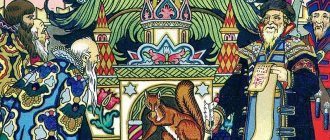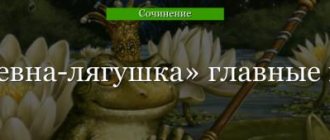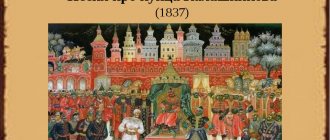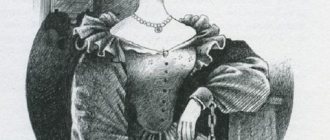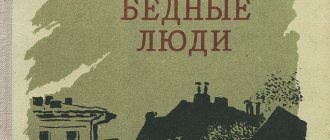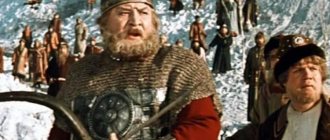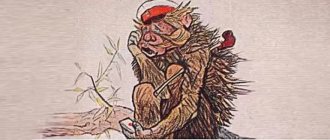In the summer of 1831 V.A. Zhukovsky lived with his pupil in Tsarskoe Selo, and A.S. was there at that time. Pushkin with his young wife. A kind of creative competition arises between the poets - both write fairy tales. The result is Pushkin's "The Tale of Tsar Saltan" and three Zhukovskys - "The Tale of Tsar Berendey", "The Sleeping Princess" and the unfinished "War of Mice and Frogs". The first of them is called magnificently, in the traditions of literature of the 18th century.
It is believed that this fairy tale is based on a plot told to Pushkin by his nanny Arina Rodionovna. Even if this is so, and this is most likely the plot of the fairy tale “The Sea King and Vasilisa the Wise,” Zhukovsky not only presented it in his own way, but also added episodes and details from other fairy tales. One feels that the poet is familiar with oral folk art, he studied it deeply and carefully, selecting what was valuable and poetic.
“The Tale of Tsar Berendey” is written in hexameter, one of Zhukovsky’s favorite meters. The hexameter “Tales of Tsar Berendey” is so “adapted” to the Russian language that it perfectly conveys the Russian fairy-tale flavor. It is so original and seems so natural in this work that it suggests some third form of speech besides prose and verse.
The plot as a whole follows the folk one. Some details introduced by Zhukovsky slightly violate the logic. For example, Koschey the Immortal reigns in the underworld. This is quite natural - he is an evil spirit of darkness. Moreover, his palace “was carved entirely from carbuncle stone.” If we recall the fairy tale “The Red Carbuncle” translated in 1816 by Zhukovsky, this stone was given to the hero by Satan.
Koschey
Let's take a closer look at Koshchei's portrait. Pearls, claws instead of hands, green eyes - all this is a portrait of the king of the sea, not the underground. Perhaps the portrait retains a hint of the hero of a folk tale.
Each character of Zhukovsky is individual, character traits are manifested in actions. Not having caught up with the fugitives (Ivan Tsarevich and Marya Princess), Koschey, in anger, “mercilessly crossed every single servant.” Such behavior is typical of some tyrant landowner, and not of the omnipotent ruler of the underworld. Koschey loves buffoonery. When Ivan Tsarevich meets, he crawls on his knees, which causes Koshchei to laugh, and he changes his anger to mercy. Also a very recognizable detail. The fantastic is supported by the quite convincing realistic. Around the fairy-tale palace, which, by order of Koshchei, Ivan Tsarevich must build, there is supposed to be “a regular garden, and in the garden a pond with crucian carp.” There is a similar detail in the description of Mishensky, the estate of Zhukovsky’s father, where the poet spent his childhood and youth.
About Tsar Berendey.
I think everyone knows who Tsar Berendey is. This is a character from Ostrovsky’s fairy tale “The Snow Maiden”, the ruler of the Berendey kingdom.
It’s just that both the tsar and the kingdom appeared in Russian literature in the 19th century, and the Berendeys, as a nomadic people with the absence of any kingdom of their own, existed even before Ostrovsky, so we’ll have to start with them. Who are they, where did they come from.
The Berendeys were initially considered a nomadic people of Turkic origin in the Eastern European steppes; in chronicles they were sometimes called either “torks” (apparently from the Turkic people) or “black hoods”
(black caps)
It is known from the chronicles that in 1097 they entered into an alliance with the Pechenegs, in 1105 they were defeated by the Cumans, and in the 13th century the name of this people disappears from the chronicles. During the Mongol-Tatar invasion (beginning in 1237), the last remaining Berendeys were partially assimilated into the Golden Horde, and partially went to Bulgaria and Hungary.
Marya the Princess
Princess Marya is not only the daughter of Koshchei, a wise sorceress, but also a lovely girl, gentle, meek, loving. Perhaps this image was created with the thought of the unforgettable Masha Protasova, a person of extraordinary charm and refined soul. Princess Marya remains a “white stone by the road” in anticipation of her betrothed; she turns into an azure flower without waiting for Ivan the Tsarevich. “The dewdrops of tears on the blue leaves sparkled.” The heroine of a folk tale is not distinguished by such sophistication; she knows in advance how events will unfold. The heroine of Zhukovsky (“The Tale of Tsar Berendey”) suffers, is insulted, is ready for self-sacrifice, but also to fight for happiness. So, the name was changed not by chance.
The image of Berendey in folklore
The king with a long beard and boundless faith in the people under his control has a curious origin story. His biography is not known accurately. Researchers and literary scholars have found that the history of this folk hero goes back deep into ancient times. Berendeys were people from Turkic tribes who roamed the steppe from the 11th to the 13th centuries. The first mention of them in chronicles dates back to 1097. It was about interaction with the Pechenegs and Torques - tribes that concluded a truce with Prince Vasilko Rostislavich. Readers familiar with The Tale of Bygone Years know about it.
History says that the Berendeys fought with the Polovtsians and were participants in the civil strife of the Russian princes. Acting as vassals, they did not want to obey the Russians and often clashed with the princes. The representative of this tribe, Tsar Berendey became a collective image. Either a werewolf, or a man, or an animal, this hero figured in the history of Rus'. Or rather, his descendants.
Leader of the Berendey tribe (art)
Historians claim that the Berendeys were among the servicemen subordinate to Yuri Dolgoruky. Submitting to Prince Yaropolk Vladimirovich, they opposed Vsevolod Olgovich in the battle of 1139. Thirty thousand Berendeys stood up to defend the prince. Evidence of them is kept in the Vladimir-Suzdal lands. Researchers suggest that Dolgoruky resettled the Berendeys from Porosye. People began to settle in Russian cities, while founding their own. The Kyiv rulers awarded the Berendeys a region near the Ros River, where Rostovets had once been located. The theories of historians describe the assimilation of the Berendeys into the Tatar-Mongol tribes after the invasion of the yoke.
The Berendeys had their own mythology. The forest was a sacred place for them. The tribes performed rituals to worship nature, honor the resources given to them and use them wisely. Fortune telling and predictions are a tradition of this people, so Tsar Berendey often appears as a hero endowed with magical abilities and power.
Ivan Tsarevich
Ivan Tsarevich also has a pronounced character. He is brave, a trip to the underworld does not scare him. Full of royal dignity. When meeting Marya the Princess, he is tactful and noble. “Having modestly walked away, he stood behind a bush.” He is religious, like his parents. The cross and amulet help him get rid of Koshchei's pursuit.
By individualizing his heroes, Zhukovsky strives to convey their inner world and make them more interesting for the reader. For the same purpose, he introduces a portrait, a landscape, and a description of interior details. Such means of expression are not typical for folk tales.
Other retellings and reviews for the reader's diary
Vitaly Bianchi's fairy tale “The Sly Fox and the Smart Duck” tells the story of how one day in the fall the Sly Fox wanted to eat a duckling. He went to the lake, crept up from behind the bushes and saw a large flock of ducks.
Adamovich’s book “The Khatyn Tale” is dedicated to the horrors of the Great Patriotic War. The Germans fight with the cruelty that is inherent only in wild animals. Fierce fighting does not stop.
The book is about Benjamin Driscoll. At the age of 31, Benjamin decided to green the planet Mars. For 30 days he lived on Mars.
Nikolka Koshevoy is an eighteen-year-old guy. He is ashamed of his age because he is smart and brave beyond his years. At eighteen, he is a squadron commander. He managed to safely eliminate two very dangerous gangs.
During bad weather, many travelers take shelter at the inn. The house is stuffy, hot, and it’s hard to sleep. One of the guests notices that the man is being led by an angel, just like he himself once was. Travelers ask to tell this story.
Source
Language features
In the field of language, the poet also violates the usual canons. Along with traditional fairy tale expressions (“neither can be said in a fairy tale, nor described with a pen”, “two deaths cannot happen, but one cannot be avoided”, “neither light nor dawn”, “not seen by sight, not heard of”, “by mustache flowed, but didn’t get into the mouth” and many others), constant epithets (“red maiden”, “dense forest”, “white stone”, etc.) Zhukovsky introduces comparisons that are completely atypical for folklore (“with a voice as clear as strings”, “in a voice as sweet as a flute”, “jumped up like crazy”, “the king shook himself off like Gogol”, etc.). In “The Tale of Tsar Berendey” there are no repetitions characteristic of oral folk art. The poet limits himself to laconic remarks: “he told everything,” “he revealed a terrible secret,” etc. All of Zhukovsky’s innovations, of course, distance his tale from the folk tale, but make it more poetic, beautiful, and fascinating.
Source: Children's literature: Textbook / E.E. Zubareva, V.K. Sigov and others - M.: Higher. school, 2004
267
S. V. BEREZKINA
PUSHKIN FOLKLORE RECORDING AND “THE TALE OF TSAR BERENDEY” BY V. A. ZHUKOVSKY
The moments of the most active and fruitful collaboration in the works of such major poets of their time as Pushkin and Zhukovsky have invariably attracted and are attracting the attention of researchers, because they allow us to find problems that are relevant for the historical and literary era, pushing artists to joint efforts to successfully resolve them. Such moments in the creative biography of Pushkin and Zhukovsky include the Tsarskoye Selo autumn (August-September) of 1831, when the two poets simultaneously worked on creating poetic tales in folklore style. The closeness of their creative aspirations is evidenced by the fact that both poets relied on authentic folklore recordings made by Pushkin, according to M. A. Tsyavlovsky, in Mikhailovsky in 1824. One of the sources of Pushkin’s “Tale of Tsar Saltan” was his recording “A certain tsar planned to get married,” while Zhukovsky, when working on his “The Tale of Tsar Berendey,” used a different entry, beginning with the words “A certain tsar was going to war.”
This reliance on “living” folklore material in the work of two authors of poetic fairy tales is significant. At a time when Russian folkloristics was still in its formation stage, this was an exceptional step in its boldness. Disputes around folklore and its role in the formation of truly folk literature are one of the painful points of the historical and literary process of that time. Questions about the national specificity of Russian folklore, its correlation with the artistic heritage of other European nations, and finally, about the ways of direct penetration of folklore material into the literary practice of the era were brought to the fore. The complexity of the tasks facing Russian literature is evidenced by the discord that accompanied the discussion of issues related to folklore and literary folklorism on the pages of magazines. From N. Polevoy’s ultra-romantic ideas about free creativity in the “folk spirit” to Belinsky’s purely “real” view of Russian folklore and its place in national culture - this is the range of judgments expressed by Russian criticism on the range of problems we have indicated.
Pushkin and Zhukovsky, who turned to authentic fairy-tale records, countered these disputes with their own solution, innovative for the given historical and literary situation, to the question of how to work with folklore material. For Pushkin and Zhukovsky this was a guarantee of fidelity
268
folk poetic traditions, which under their pen acquired a different quality as a result of the synthesis of two principles - literary and folklore. The uniqueness of the position of artists on the issue of a literary genre, which takes folklore as its basis, becomes especially clear when studying the creative history of works, which reveals the difficulties that poets encountered when working on folklore material. If in relation to Pushkin’s “The Tale of Tsar Saltan” folk poetic sources, which determined the ideological and artistic originality of the work, have already received sufficient coverage, then Zhukovsky’s tale in its connection with Pushkin’s folklore record still harbors a number of questions that require resolution.
The entry “A certain king was going to war,” which Zhukovsky used, is found in the third Masonic notebook (No. 836, filled out in 1824-1827) among the seven fairy tales heard and written down by Pushkin. Zhukovsky undoubtedly understood the value of the materials that he had the opportunity to familiarize himself with. In 1840, sending A.P. Elagina materials for his planned “Library of Folk Tales” (this enterprise did not materialize), Zhukovsky wrote: “I am sending more Russian fairy tales, which I found in the papers left after Pushkin; I ask you to take care of them.” What did Zhukovsky send to Elagina - copies or Pushkin’s autographs? Apparently, the last assumption is correct, because Zhukovsky urged his correspondent to “take care” of the notes he sent. In addition, was this the third Masonic notebook, which included Pushkin’s folklore notes, or did the poet send Elagina papers that were later lost and unknown to modern science? We currently do not have an answer to this question, but we can assume that Zhukovsky was familiar with a larger number of fairy tales recorded by Pushkin than those that are now known to us.
For the first time, P. V. Annenkov pointed out Zhukovsky’s use of one of Pushkin’s notes in “The Tale of Tsar Berendey.” An additional source for the work was discovered by C. S. Wolpe: this is a fairy tale from the collection of the Brothers Grimm “Der liebste Roland”, in the poet’s translation it was called “Dear Roland and the Clear Flower Maiden” and published by the magazine “Children's Interlocutor” in 1826.
Having compared the sources in their relation with the text of “The Tale of Tsar Berendey”, Volpe came to the following conclusion: “Zhukovsky initially wanted to limit himself to the motives of Pushkin’s recording <...> and then directly began to retell the Grimms’ text” (Zh., II, 471). Moreover, it was the German fairy tale that, according to the commentator, had a decisive influence on Zhukovsky when working on the work (Zh., II, 471).
The researcher’s conclusion was disputed by I. P. Lupanova: “Firstly, the “retelling” <...> of Grimm’s fairy tale takes up only 35 lines out of 432 lines (according to our calculations - 67, however, motives from Pushkin’s recording are also intertwined here. - S. B.
) <…> Secondly, the fairy-tale motifs found in this “retelling” are not specific to Grimm’s text: they can also be found in Russian fairy-tale folklore.” In her opinion, the “inclusion” of a fragment of a German fairy tale into a work
269
Zhukovsky “in no way gives reason to consider Grimm’s fairy tale as the source of “Berendey”, equivalent to the Russian one.”
So, we have two points of view on the question of the place of “Dear Roland” in the structure of Zhukovsky’s work: on the one hand, the undoubted belittlement of the role of the recording of the folk tale that the poet had, and on the other, a biased attitude towards a foreign language source associated with the idea of “ discrediting" the work by the inappropriateness of someone else's material in a literary fairy tale focused on Russian folklore. The solution to this question can be found by studying the main text and draft manuscripts of The Tale of Tsar Berendey, as well as comparing them with Pushkin's account, the Brothers Grimm fairy tale and Zhukovsky's translation of Dear Roland. This is all the more necessary because T. G. Leonova, who undertook a detailed comparative analysis of Pushkin’s recording with Zhukovsky’s work, found it possible to do without even mentioning “Dear Roland”, nevertheless coming to the conclusion that the author of “The Tale of Tsar Berendey” “follows very closely the plot of the folk tale” recorded in Mikhailovsky.
Pushkin's fairy-tale record and Zhukovsky's work compositionally fall into two parts: Ivan Tsarevich with Marya the Tsarevna in the dungeon of the immortal Koshchei, from where they flee (Part 1), and their return home, complicated by the episode of the groom forgetting his bride (Part 2 ). Ts. S. Volpe published the initial version of the ending of Zhukovsky’s work, which in this edition ends with the escape of the heroes (Zh., II, 455). According to Volpe, work on the second part of Pushkin’s recording was not included in Zhukovsky’s plans, therefore, having crossed out the original version of the ending of the tale, the poet began to “retell” “Dear Roland” (Zh., II, 471). In reality, the situation was much more complicated.
The description of the manuscripts of “The Tale of Tsar Berendey” given by Volpe (J., II, 470-471) suffers from significant inaccuracies, which determined the nature of their interpretation by the researcher. Manuscripts of the tale are stored in the Manuscript Department of the State Public Library. M. E. Saltykova-Shchedrin. The beginning of the work up to the lines “Wait! I will get to you, Friend” - f. 286 (V. A. Zhukovsky), op. 1, units hr. 30, l. 75 rev. - 78 rev., 79 rev. - 80. On l. 75 rev. extensive side view; on l. 80 another plan (published by Volpe - J., II, 470). At the beginning of the tale on l. 75 rev. date - “August 2”. Continuation of the tale (and to the end) - f. 286, op. 1, units hr. 35, l. 5 rev. - 8. Under the first version of the ending (fol. 6 vol.) the date is “September 1st”. At the end of the tale (fol. another date - “September 11th”. Authorized copy - f. 286, op. 2, item 22. On folio 1 date “1831 August 2nd” - 1 September, it is crossed out. Under the line is “September, 12.” On page 3 is the first version of the ending.
Manuscripts of the tale are stored in the Manuscript Department of the State Public Library. M. E. Saltykova-Shchedrin. The beginning of the work up to the lines “Wait! I will get to you, Friend” - f. 286 (V. A. Zhukovsky), op. 1, units hr. 30, l. 75 rev. - 78 rev., 79 rev. - 80. On l. 75 rev. extensive side view; on l. 80 another plan (published by Volpe - J., II, 470). At the beginning of the tale on l. 75 rev. date - “August 2”. Continuation of the tale (and to the end) - f. 286, op. 1, units hr. 35, l. 5 rev. - 8. Under the first version of the ending (fol. 6 vol.) the date is “September 1st”. At the end of the tale (fol. another date - “September 11th”. Authorized copy - f. 286, op. 2, item 22. On folio 1 date “1831 August 2nd” - 1 September, it is crossed out. Under the line is “September, 12.” On page 3 is the first version of the ending.
In his publication of the first version, Volpe referred specifically to the authorized copy. Meanwhile, it is also present in the draft manuscript of the fairy tale, but the textual situation here is somewhat different. Zhukovsky intended to continue the work after the rescue of the heroes from the kingdom of Koshchei (the second part of Pushkin’s entry):
Ivan Tsarevich with his
Tsarevna Marya drove away, no longer afraid of pursuit. Here they are going in small steps <2 nrsb
.> The sun is already leaning towards the west.
Zhukovsky crossed out these lines, and only then followed the ending of the tale given by Volpe. In turn, having crossed it out, the poet continued
270
work on the work from the same lines, slightly modified.
There is other evidence that Zhukovsky from the very beginning did not intend to leave work on Pushkin’s note without completely exhausting it. On the first pages of the tale, the poet sketched two plans. In the most extensive part, its final part attracts attention: “City. You will forget me. Child
.
I forgot. Wedding
.
Cook. Pie. Pigeon.
Return. Feast". The end of another shot looks like this: “City. Wedding. Cook. Table. He will find out" (J., II, 470). There is nothing from “Dear Roland” in these sketches - they represent a summary of Pushkin’s entire recording, including the final episode (the groom forgetting his bride). One of the plans (the most extensive) is included on the first page of the draft manuscript of the work, which indicates Zhukovsky’s original intention to rework Pushkin’s recording of the folk tale completely. However, this intention was abandoned, and Zhukovsky, contrary to his original plan, interrupted work on Pushkin’s outline.
As the poet's manuscripts testify, it was precisely a break in work when Zhukovsky, having completed, as it seemed to him, the work, put it aside, and then returned to his fairy tale. Modern commentators on Zhukovsky's work (following Volpe) date this work of the poet as follows: August 2 - September 1 (Zh., II, 470). The study of manuscripts allows us to clarify the dating of this tale as follows: August 2 - September 12. In the draft notebook, under the first version of the end of the work, there is a date: “September 1st.” Zhukovsky allowed the completed work, as it seemed to him, to be whitewashed, so the authorized copy was originally dated by the poet as follows: August 2 - September 1. It was then that the first part of the fairy tale was created - Ivan Tsarevich and Marya Princess in Koshchei’s dungeon. However, Zhukovsky continued to work on the work and, having completed it, put the date “September 11” in the draft notebook, and in the authorized copy under the date “August 2 - September 1” he wrote: “12 September <October>". Ts. S. Volpe pointed to these dates (both September 11 and 12), however, from his point of view, they were given by Zhukovsky in the new style (Zh., II, 470). This is incorrect: September 12 is the day the “Tale of Tsar Berendey” ended, when the poet made numerous corrections to the authorized copy of the work. V. A. Zhukovsky, when he lived in Russia, did not have the habit of dating his works according to the European calendar, as evidenced not only by notebooks with drafts of fairy tales, but also by the poet’s letters.
It must be admitted, however, that in the three lists compiled by Zhukovsky indicating the time of creation of the works and including “The Tale of Tsar Berendey”, the date “August 2 - September 1” is indicated. Apparently, the break in work on the work was significant (several days), and the author himself perceived “The Tale of Tsar Berendey” for some time as a completed work, while the lists were compiled before work on the tale continued.
Comparing the dates of writing Zhukovsky’s Tsarskoye Selo works, we find that “The Tale of Tsar Berendey” was completed by the poet simultaneously with “The Sleeping Princess” (work on it began on August 26). The Sleeping Princess was based on a fairy tale from the collection of the Brothers Grimm, also translated by Zhukovsky and published in 1826. Apparently, to work on this fairy tale, Zhukovsky hurried to finish his Berendey. At the same time, the poet’s “Sleeping Princess” helps us reconstruct the process of creating the first Tsarskoye Selo fairy tale
271
Zhukovsky. When starting to write it, the poet intended to transform the entire Pushkin record, but he did not have Grimm’s fairy tale in mind. The idea of translating the fairy tale, made in 1826, came to Zhukovsky while working on The Sleeping Princess. Moreover, “Dear Roland” in its correlation with Pushkin’s folklore record so suddenly struck him that the poet considered it necessary to return to work on “The Tale of Tsar Berendey.”
Habitually using comparative indexes of fairy tale plots according to A. Aarne’s system, none of the researchers paid attention to Zhukovsky’s accuracy in choosing an additional source for the work: both the fairy tale recorded by Pushkin and Grimm’s text belong to the same type of plot. It seems that it was precisely this closeness of two fairy tales - Russian and German - that attracted Zhukovsky. M.K. Azadovsky wrote: “It is remarkable that Pushkin was one of the first to understand the international nature and significance of folklore. And he dwells with particular interest on subjects that were known to him from both Russian and Western sources.” Later, A.D. Soimonov also noted that Pushkin’s appeal to one or another fairy tale plot is often explained by its “prevalence in both the Russian and Western European repertoire.” This can rightfully be attributed to Zhukovsky, who was able to notice the international nature of the subjects that attracted his attention. At the same time, the poet’s appeal to “Dear Roland” was also due to the difficulties that he encountered in the process of working on Pushkin’s recording of the folk fairy tale plot.
Let's take a closer look at how Zhukovsky follows this record. According to T. G. Leonova, “he retained literally all the plot links,” with the exception of “the last episode of the fairy tale (the hero forgetting his bride).” However, there is one more episode, not noticed by the researcher, where the poet deviated from the plot recorded by Pushkin: “Walking one day on horseback, he met an old man who began to blame him for not appearing yet and that his deadline had passed. Ivan-Tsarevich demands and receives an explanation from his father. The old man appears to him 3 times and teaches him where to go.” Noteworthy is some ambiguity in the text: is this the same old man who lured the oath out of his father, sitting at the bottom of the well, or someone else? where and under what conditions does he appear to Tsarevich Ivan? finally, why does he come three times if the prince has already received an explanation from his father? One cannot but agree that this fragment of Pushkin’s notes is sketchy, not even clear (this is how M. A. Tsyavlovsky characterized Pushkin’s notes). We restore its plot with the help of other publications of this fairy-tale plot, but Zhukovsky got out of the situation in the following way: in his fairy tale there is “some wonderful old man” who blames his son for his father’s debt (the same one who sat at the bottom of the well), but there is no old man who would come three more times. Therefore, Ivan Tsarevich himself finds the way to the lake and finds an assistant in the person of Princess Marya only thanks to his resourcefulness.
272
Something similar, in our opinion, happened with that fragment of the fairy tale into which Zhukovsky introduced an episode from “Dear Roland.” In Pushkin’s entry we read: “Iv<an>-ts<arevich> and M<arya-princess> enter into their state. “You will forget me, Ivan-tsarevich, do not kiss the child when you come to your father and mother, otherwise you will forget me.” Ivan-tsarevich comes to his father’s mother, kisses the child in delight and forgets Marya-tsarevna.” Regarding this situation, V. Ya. Propp writes (he is talking about a fairy tale from Afanasyev’s collection “The Sea Tsar and Vasilisa the Wise,” which belongs to the same plot type as that recorded by Pushkin): “Here it is puzzling: what actually makes Should Vasilis stop on the road? There are no obstacles in the fairy tale that prevent her from simply entering the city with the prince.” The researcher gave a historical interpretation of this situation (initiation rite, men's house, etc.). Folk storytellers also understood the need for her explanation, relying on village etiquette: “Vasilisa the Beautiful says: “Go ahead, prince, report to your father and mother, and I’ll wait for you here on the road.” Compare: “Before, you didn’t dare to come over with your wife like that, right away.” Thus, in folk tales, the bride's waiting for the groom outside her parents' house is explained by peasant custom. In Pushkin's account there is no motivation for the bride's refusal to follow the groom. Apparently, the concise nature of the recording forced Zhukovsky to look for his own explanation for the actions of fairy-tale characters.
Grimm's fairy tale attracted the poet with the elaboration of its psychological motivations: it is not the modesty of the bride, who does not dare cross the threshold of her chosen one's parental home (this was left outside the scope of Pushkin's recording), but submission to fate (the hero is destined to forget her) that explains the girl's readiness to wait for her groom. Thus, the brevity of the folklore record that Zhukovsky had at his disposal led him, in one case, to the need for its logical conjecture, and in another, to the search for another source, which made it possible to fill in a not entirely clear fragment of the text.
Turning to “Dear Roland,” Zhukovsky omitted the initial episodes of the fairy tale associated with the persecution of his stepdaughter by his evil stepmother. What is the nature of the introduction of a fragment from “Dear Roland” into “The Tale of Tsar Berendey” by Zhukovsky? First, it should be noted that when creating the work, Zhukovsky was guided not by the German text, but by his translation, about which E. Eleonskaya wrote that it was “very close to the text of the German fairy tale from the collection of brothers. Grimm, and the usual changes in words and phrases for Zhukovsky occur constantly.” However, these changes are so characteristic that it is the translation of “Dear Roland” that is recognized in “The Tale of Tsar Berendey,” evidence of which we will provide during the analysis.
The rough manuscripts of the work reveal greater proximity to “Dear Roland” than the final text of the tale. Regarding the transformation of Princess Marya into stone (a motif borrowed by the poet from a German fairy tale), I. P. Lupanova rightly noted: “Already in the translation of “Dear Roland,” Zhukovsky replaced the transformation of the heroine into a “roadside pillar of red stone” with the transformation into a “red field stone". When creating a Russian fairy tale, he used an image that is characteristic of Russian folklore: a white stone.” I wonder what
273
Initially, in the draft of the fairy tale, Zhukovsky’s stone was still red:
Go, I'll stay
As a red stone, I will stand on < rnzb.
> road.
During the work, Zhukovsky made the appropriate changes and replaced the red stone with white.
Not only this detail allows us to tell us that the draft manuscript of “The Tale of Tsar Berendey” is closer to “Dear Roland”. The old man, in whose hut Marya the Princess appeared in the form of a blue flower, was originally a “young shepherd,” and the corresponding corrections were made by Zhukovsky only in an authorized copy. Let's compare the texts. Draft manuscript: “A young shepherd boy walked; he saw an azure flower.” "Dear Roland", trans. Zhukovsky: “A young shepherd was walking along the road and saw a blue flower.” Finally, the main text: “Dear at that time | An old man was walking; he saw a blue flower by the road” (J., II, 48). However, in the main text the following line remained as a rudiment: “Quickly from bed | The old man snorted and covered the flower with a handkerchief” (F., II, 48). “Spice” in relation to an old man looks somewhat strange, but this combination takes on a different character if instead of “old man” we put “shepherd”, as was the case in the manuscript of the fairy tale.
The reason for these changes is clear. “The Young Shepherd” clearly contradicts the spirit of Russian fairy tales and the source that was the basis of Zhukovsky’s work. At the same time, the author probably also had in mind considerations, so to speak, of a plot nature. If the “young shepherd boy” sees a beauty in front of him, then, naturally, he must fall in love with her, as is what happens in the fairy tale of the Brothers Grimm. However, neither in the main nor in Zhukovsky’s draft text is there such a motive, and therefore, the character does not necessarily have to have such a characteristic as youth.
In general, Zhukovsky’s adherence to the fairy tale he translated is beyond doubt. Let's compare the texts. "The Tale of Berendey":
And at the same moment from white stone
Princess Marya turned into the azure color of the field. “I’ll stay here by the road, maybe someone will trample me into the ground.”
(J., II, 48)
"Dear Roland", trans. Zhukovsky: “And she turned into a blue flower and thought: maybe someone will crush me.”
"The Tale of Berendey":
From that very moment
Everything was no longer the same in the hut; something wonderful began to work in it: the old man would wake up - and everything in the hut was already tidied up as it should be; there is not a speck of dust anywhere.
(J., II, 48)
"Dear Roland", trans. Zhukovsky: “And from that moment everything in his hut was not the same; miracles happened in it. Before the young shepherd has time to wake up in the morning, everything in his hut has already been tidied up and the dust has been swept away.”
274
Thus, Zhukovsky followed his translation of “Dear Roland” quite accurately.
At the same time, C. S. Volpe drew attention to the correspondence of individual motifs in Pushkin’s recording and the fairy tales of the Brothers Grimm (Zh., II, 471). Zhukovsky tried to make maximum use of this relationship in order to achieve the effect of interpenetration of the two sources.
First of all, let us pay attention to the motivation for the groom’s “oblivion” of his bride in both texts. If in Zhukovsky’s translation Roland simply forgot her (“Dear Roland did not return, dear Roland forgot about her”), then in the German fairy tale the situation was somewhat different: “Als aber Roland heim kam, geriet er in die Fallstricke einer andern, die es dahin brachte, daß er das Mädchen vergaß.” Zhukovsky, in his work, retained the motivation of Pushkin’s note (“child,” as it was indicated in his plans).
Let us also note that in “The Tale of Tsar Berendey” Princess Marya, in the form of a white stone, waits for her groom for three days; in Zhukovsky’s translation it was said: “And for a long, long time she waited for dear Roland” (cf. the Grimms: “Das arme Mädchen stand lange Zeit”). Finally, if in Zhukovsky’s translation of a German fairy tale a shepherd asks for advice “from an old woman” (cf.: “die weise Frau” - “wise woman”), then in “The Tale of Tsar Berendey” she becomes an old woman fortuneteller (Zh., II , 48). All these changes are in the same vein as “white stone” instead of “red”, “old man” instead of “young shepherd”. Zhukovsky Russifies his German source, bringing it closer to a different folklore system. The principles of his transformation of Grimm’s fairy tale are similar to Zhukovsky’s processing of Pushkin’s account: he retells the German fairy tale in an expansive manner, supplementing it with the realities of Russian fairy-tale life and complicating the psychological characteristics of the heroes of the work.
Let's summarize some results. The basis of “The Tale of Tsar Berendey” was Pushkin’s recording. However, taking advantage of the ambiguity of individual episodes of this recording, as a consequence of its summary nature, Zhukovsky introduced a fragment of his translation of the fairy tale by the Brothers Grimm, which, as it were, filled in the gap in Pushkin’s summary. Enriched with new details and descriptions, the German fairy tale under the pen of Zhukovsky intertwined with the Russian one, which had not exhausted its plot possibilities. The motif of the “kiss of a child” preserved by Zhukovsky (the consequence of which should be the groom’s “oblivion” of his bride) made it possible to resume further narration on the basis of Pushkin’s folklore recording. Having exhausted the fragment of the German fairy tale that attracted the poet (the transformation of the heroine into stone, then into a flower, her life in an old man’s hut, the return of her human appearance), Zhukovsky, as it were, again picks up the broken thread of the plot of the main source and continues to work on it where he left off. This is the place of each of the sources in Zhukovsky’s work on “The Tale of Tsar Berendey.”
According to Ts. S. Volpe, this tale also has a third source - an epic from the collection of Kirsha Danilov “Sadkov’s ship came to sea” (Zh., II, 472). I. M. Semenko explains the inclusion of the epic among the sources of the work: it is in it that “the image of the immortal Koshchei is given as the king of the “underground” or underwater kingdom, which does not coincide with the traditional interpretation of Koshchei in Russian folk tales” and is close, in her opinion, to the character Zhukovsky. Indeed, Koschey in “The Tale
275
about Tsar Berendey” does not resemble the fabulous Koshchei the immortal, familiar to us from Russian folklore. Here, for example, is his portrait description, corrected by the poet only in an authorized copy:
Ivan Tsarevich bravely
He enters and sees King Koshchei on a huge throne. He was wearing a crown of fire, with a green beard; Eyes sparkled like two emeralds; hands with claws. He seemed all made of copper; broad shoulders Were covered with porphyry, as if woven from the light blue of the sky.
The final text contains only:
Ivan Tsarevich bravely
Enter: Koschey sits on the throne wearing a light crown; The eyes sparkle like two emeralds; hands with claws.
(J., II, 42-43)
Ts. S. Volpe saw the prototype of this character of Zhukovsky in the epic of Kirsha Danilov, and yet it is not about the immortal Koshchei, but about the king of the sea. To understand the train of thought of the researcher who settled on this source, let us turn to his argumentation.
Firstly, Volpe points out, the epic “talks about an underwater sea king offering Sadko a choice of one of his thirty daughters” (Zh., II, 472). However, this riddle is also in Pushkin’s record, so Zhukovsky did not need to look for it in “Ancient Russian Poems,” especially since this motif is one of the most widespread in Russian folklore. In addition, the conditions for fulfilling it in the epic are different from those in fairy tales: the daughters of the sea king do not resemble each other in appearance. Volpe writes: “There is a similarity <...> in the name Koshchei “underground king” (underwater or submerged sea king)” (Zh., II, 472). Why should the expression “underground king” mean “underwater king”? There is not even a hint of this in the fairy tale; Koschey invites Ivan Tsarevich “to us in the underground kingdom” (Zh., II, 43). On the other hand, in the epic there is simply a “sea king”; he is not called anything else. “The description of Koshchei’s underground palace,” says Volpe, “is also very similar to the description of the palace of the sea king” (J., II, 472). Here is the only image of the “palace” of the sea king, which is given in the epic:
Sadko went near the blue sea, He found a great hut, And a great hut in the whole tree, He found a door, and went into the hut. And the king of the sea lies on the bench.
Further: “The wrath of the underground king Koshchei,” writes Volpe, “makes the vaults of the underground kingdom tremble (compare with the wrath of the sea king)” (J., II, 472). Unfortunately, this task (to compare) is impossible, because the sea king in the epic is not angry at all, but only dances, rejoicing at the arrival of Sadko, which is why “the blue sea shook.” However, C. S. Wolpe still has an argument that deserves serious attention.
The researcher writes: “Precisely because Zhukovsky altered the image of the sea
king, the signs of his Koshchei are the attributes of fairy-tale symbolism, associated specifically with ideas about the kingdom of the sea <...> It is characteristic that Koschey extorts a promise from Berendey, sitting at the bottom of a well in the water
"
(Zh., II, 472). He also noted the following
276
details in the portrait of Koshchei: “Eyes like two emeralds; hands with claws." It would seem logical to assume that such an unusual portrait characteristic passed to him from the prototype - the epic sea king, however, there are no such details in the text of Kirsha Danilov. In search of the prototype of this character, let's try to take a closer look at the fairy-tale plot that Zhukovsky worked on.
In comparative indexes it is designated under the heading “Miraculous Escape.” The annotations to the plot, compiled by N. P. Andreev and V. Ya. Propp, indicate that the enemy of the hero (prince) in the fairy tale is the water king. Only in the latest, currently most authoritative index of fairy-tale plots, a significant addition was made: an oath from the father of a young man can be lured out by a devil, a sorcerer, etc. This addition, introduced into the index relatively late, testifies to the rarity of fairy tales where the villain is not the water king. Pushkin's entry is one of them. However, who is the villain who is trying to destroy the prince in the fairy tale that Pushkin heard? It does not fit under any of the headings named in the indexes we mentioned. In the “hole”, “a certain king” is grabbed by the beard by “someone” (a certain fairy-tale creature), then this “someone” is once called an “angry old man” and six times simply “a king”. Where does the “angry old man” reign? We read: “They descend into the underground kingdom.” Consequently, the “angry old man” is the ruler of the underground kingdom (the rarest option in Russian fairy-tale folklore). However, at the beginning of the tale, this underground king for some reason sits in a well, where he lures an oath out of Berendey. And in this case, why shouldn’t he have claws, green eyes and a beard, if from time to time he changes his underground kingdom to the “pigeon”?
Zhukovsky was very logical in his work on Pushkin’s recording, and he proceeded in developing a fairy-tale plot from it, without introducing epic plot motifs into the work. With the help of his imagination, the poet developed what was contained in Pushkin’s notes. The only question that remains unresolved is: why is this character of Zhukovsky called Koshchei the immortal? In Pushkin’s account, this is simply a king, but the fairy-tale hero should have been given a name, and Zhukovsky names the ruler of the underground kingdom Koshchei. This, by the way, reflected Zhukovsky’s insufficient knowledge of Russian folklore: he did not feel how far the image he created was from the Koshchei of genuine folk tales.
The history of the name of another character of Zhukovsky - Tsar Berendey - is interesting. As K.V. Chistov points out, it “is found in Russian fairy tales, but probably <...> fell into the oral tradition under the influence of the famous fairy tale by V. A. Zhukovsky.” In this case, the question arises: where did the name Berendey come from in the poet’s fairy tale? Unexpected light on its origin is shed by the poems of one of Zhukovsky’s contemporaries, the famous graphomaniac poet D.I. Khvostov, who addressed the poet with a message in which he tried to give the fictional fairy-tale character a very real place of residence - on the banks of the Kubra, where Khvostov’s estate was located. This river, repeatedly sung in his poems, flows near the Berendeyev swamp (now Pereslavl-Zalessky district of the Yaroslavl region):
277
Do you know that in ancient times my Kubra was in his mighty kingdom? Tsar Berendey, with his pomp and wealth, almost pinched his beard in the wrong place?
Khvostov's playful assumption was apparently correct. The name of the fairy-tale hero came into Zhukovsky’s work from the legend about the kingdom of the “happy Berendeys,” which was later used by A. N. Ostrovsky in his “The Snow Maiden.” According to legend, not far from Pereslavl-Zalessky in ancient times there existed a rich city of Berendeys, on the site of which the Berendey swamp is now located. According to legend, this city was owned by the powerful Tsar Berendey. Khvostov explains: “The landowner of the village of Petrovskoye, Nikolai Petrovich Makarov, while draining the Berendeevo swamp, which belongs to him, found signs of an ancient city or village, where he discovered fragments of a wooden pavement, piles of stones, a city earthen rampart and the location of streets.”
Apparently, the first mentions of this settlement appeared in our literature at the end of the 1810s. M. N. Makarov wrote about him repeatedly. In his “Journal of Pedestrians”, published in 1830 (excerpts from it were previously published in the “Ladies’ Magazine”), we find several lines about the “ancient Berendey royal well”, which received its name thanks to Catherine II: during a trip to Russia she I had a chance to try the wonderful water from this well. Apparently, Zhukovsky, while working on the tale, relied on these references to the Berendey kingdom. Moreover, it is possible that he tried to give his own, “fairy-tale” explanation of the circumstances due to which the well, located near the legendary city, received the name “Tsar’s” and “Berendeev”.
The legend about the kingdom of the Berendeys attracted Zhukovsky with its historical basis: the Berendeys (torks, hoods) are mentioned in Russian chronicles of the 11th-12th centuries, N.M. Karamzin reported about them in his “History of the Russian State”. By giving the name Berendey to “a certain tsar” in Pushkin’s account, Zhukovsky thereby tried to merge folklore and historical elements. The attempt to synthesize them was a success: the legendary Tsar Berendey, following the work of Zhukovsky, firmly entered the Russian fairy tale tradition. Consequently, we are dealing with the assimilation of literary fairy tales by folklore - expressive evidence that Zhukovsky’s first experience in a new genre turned out to be extremely successful.
The creative history of “Tales of Tsar Berendey” reveals features specific to the historical and literary era in working with folklore material. This is, first of all, the desire to rely on the “living” word heard from the lips of the people. A literary fairy tale is conceived within the strict genre framework of a “prototype,” and hence the accuracy in conveying the true storyline and the courage in depicting details and characters inherent in the author of “The Tale of Tsar Berendey.” The Russian literary fairy tale in the folklore style ensured its originality and dissimilarity from other Western European examples of the genre precisely by its direct reliance on folk poetry.
278
material. And in this sense, the work of Pushkin and Zhukovsky, the two pioneers of this genre in Russia, is deeply significant.
At the same time, during the friendly contacts of the two Tsarskoye Selo “storytellers”, a wide range of issues were apparently raised, which included not only the very possibility of penetration into the consciousness of speakers of Russian folklore, but also the processing in a genre-appropriate manner of foreign language folklore elements close to to Russian fairy tales. Without taking this circumstance into account, it is impossible to understand the searches of Pushkin and Zhukovsky in this genre both in 1831 and in subsequent years.
—————
